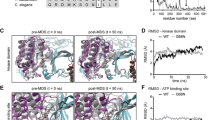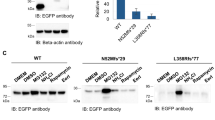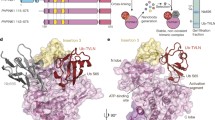Abstract
Mutations in parkin, which is encoded by the PARK2 gene, are associated with a rare form of Parkinson’s disease called autosomal recessive juvenile parkinsonism (ARJP). Parkin is a member of RBR family of E3 ubiquitin ligase. Parkin contains a RING1-In-Between-Ring (IBR)-RING2 motif. The IBR domain is located at the C-terminal end of the parkin protein. Two zinc-binding sites are present in the IBR domain which shows zinc ion–dependent folding and maintains the orientation and geometry of RING domains. So, mutation in a zinc-binding region can be responsible for improper folding of parkin protein, which eventually affects the protein structure and function. Abnormalities in parkin protein increase the aggregation of mis-folded proteins in the brain cell. As a consequence, cellular toxicity occurs. The IBR domain also interacts with UbcH7 and UbcH8 proteins belonging to E2 protein family and facilitates synphilin-1, Sept5, and SIM2 protein ubiquitination. It is reported that missense mutation in parkin protein are responsible for autosomal recessive juvenile Parkinson disease. In this work, we first collected the missense mutations in the IBR domain from literature and sequence databases. Then, using various computational tools, we predicted their pathogenicity and involvements in causing possible changes in various protein properties. Evolutionary conservation of amino acids, solvent accessible surface areas, the physico-chemical properties, and changes of protein structure were analyzed. We, for the first time, analyzed the effects of these mutations in parkin to decipher the plausible molecular mechanism of Parkinson’s disease.




Similar content being viewed by others
Data Availability
Available on request.
References
Klockgether, T. (2004). Parkinson’s disease: Clinical aspects. Cell and Tissue Research, 318(1), 115–120. https://doi.org/10.1007/s00441-004-0975-6.
Parkinson, J. (2002). An essay on the shaking palsy. The Journal of Neuropsychiatry and Clinical Neurosciences, 14(2), 223–236.
Marino, B. L., de Souza, L. R., Sousa, K., Ferreira, J. V., Padilha, E. C., da Silva, C. H., et al. (2020). Parkinson’s disease: A review from pathophysiology to treatment. Mini Reviews in Medicinal Chemistry, 20(9), 754–767. https://doi.org/10.4103/0028-3886.226451.
Hristova, V. A., Beasley, S. A., Rylett, R. J., & Shaw, G. S. (2009). Identification of a novel Zn2+−binding domain in the autosomal recessive juvenile Parkinson-related E3 ligase parkin. Journal of Biological Chemistry, 284(22), 14978–14986. https://doi.org/10.1074/2Fjbc.M808700200.
Hayashi, S., Wakabayashi, K., Ishikawa, A., Nagai, H., Saito, M., Maruyama, M., Takahashi, T., Ozawa, T., Tsuji, S., & Takahashi, H. (2000). An autopsy case of autosomal-recessive juvenile parkinsonism with a homozygous exon 4 deletion in the parkin gene. Movement Disorders, 15(5), 884–888. https://doi.org/10.1002/1531-8257(200009)15:5%3C884::AID-MDS1019%3E3.0.CO;2-8.
Yeo, C. W., Ng, F. S., Chai, C., Tan, J. M., Koh, G. R., Chong, Y. K., et al. (2012). Parkin pathway activation mitigates glioma cell proliferation and predicts patient survival. Cancer Research., 72(10), 2543–2553. https://doi.org/10.1158/0008-5472.CAN-11-3060.
Shimura, H., Hattori, N., Kubo, S. I., Mizuno, Y., Asakawa, S., Minoshima, S., Shimizu, N., Iwai, K., Chiba, T., Tanaka, K., & Suzuki, T. (2000). Familial Parkinson disease gene product, parkin, is a ubiquitin-protein ligase. Nature Genetics, 25(3), 302–305. https://doi.org/10.1016/j.bbamcr.2004.09.026.
Panicker, N., Dawson, V. L., & Dawson, T. M. (2017). Activation mechanisms of the E3 ubiquitin ligase parkin. Biochemical Journal, 474(18), 3075–3086. https://doi.org/10.1042/BCJ20170476.
Trempe, J. F., & Fon, E. A. (2013). Structure and function of Parkin, PINK1, and DJ-1, the three musketeers of neuroprotection. Frontiers in Neurology, 4, 38. https://doi.org/10.3389/fneur.2013.00038.
Seirafi, M., Kozlov, G., & Gehring, K. (2015). Parkin structure and function. The FEBS Journal, 282(11), 2076–2088. https://doi.org/10.1111/febs.13249.
Arkinson, C., & Walden, H. (2018). Parkin function in Parkinson’s disease. Science, 360(6386), 267–268. https://doi.org/10.1126/science.aar6606.
Beasley, S. A., Hristova, V. A., & Shaw, G. S. (2007). Structure of the Parkin in-between-ring domain provides insights for E3-ligase dysfunction in autosomal recessive Parkinson’s disease. Proceedings of the National Academy of Sciences, 104(9), 3095–3100. https://doi.org/10.1073/pnas.0610548104.
Zhang, Y., Gao, J., Chung, K. K., Huang, H., Dawson, V. L., & Dawson, T. M. (2000). Parkin functions as an E2-dependent ubiquitin–protein ligase and promotes the degradation of the synaptic vesicle-associated protein, CDCrel-1. Proceedings of the National Academy of Sciences, 97(24), 13354–13359. https://doi.org/10.1073/pnas.240347797.
Safadi, S. S., Barber, K. R., & Shaw, G. S. (2011). Impact of autosomal recessive juvenile Parkinson’s disease mutations on the structure and interactions of the parkin ubiquitin-like domain. Biochemistry, 50(13), 2603–2610. https://doi.org/10.1021/bi200065g.
Adzhubei, I., Jordan, D. M., & Sunyaev, S. R. (2013). Predicting functional effect of human missense mutations using PolyPhen-2. Current Protocols in Human Genetics, 76(1), 7–20. https://doi.org/10.1002/0471142905.hg0720s76.
Capriotti, E., & Altman, R. B. (2011). Improving the prediction of disease-related variants using protein three-dimensional structure. BMC Bioinformatics, 12(S4), S3. https://doi.org/10.1186/1471-2105-12-s4-s3.
Eisenberg, D., Lüthy, R., & Bowie, J. U. (1997). [20] VERIFY3D: assessment of protein models with three-dimensional profiles. In Methods in enzymology (Vol. 277, pp. 396–404). Academic Press.https://doi.org/10.1016/S0076-6879(97)77022-8
Lovell, S. C., Davis, I. W., Arendall III, W. B., De Bakker, P. I., Word, J. M., Prisant, M. G., Richardson, J. S., & Richardson, D. C. (2003). Structure validation by Cα geometry: ϕ, ψ and Cβ deviation. Proteins: Structure, Function, and Bioinformatics, 50(3), 437–450. https://doi.org/10.1002/prot.10286.
Funding
This study is supported by the DBT-Sponsored Bioinformatics Center of Kalyani University (Grant no. BT/BI/25/001/2006), UGC-SAP-DRS-II, DST-PURSE-II.
Author information
Authors and Affiliations
Contributions
Angshuman Bagchi conceptualized the work. Sima Biswas performed the entire work. Sima Biswas and Angshuman Bagchi wrote the manuscript. All the authors agreed to submit the manuscript.
Corresponding author
Ethics declarations
Consent to Participate
All the authors agreed to participate in the scientific work.
Consent for Publication
All the authors agreed to submit the manuscript.
Competing Interests
The authors declare that they have no competing interests.
Additional information
Publisher’s Note
Springer Nature remains neutral with regard to jurisdictional claims in published maps and institutional affiliations.
Rights and permissions
About this article
Cite this article
Biswas, S., Bagchi, A. Mutational Impact on “in-Between-Ring” (IBR) Domain of PARKIN on Protein Stability and Function. Appl Biochem Biotechnol 193, 1603–1616 (2021). https://doi.org/10.1007/s12010-021-03491-2
Received:
Accepted:
Published:
Issue Date:
DOI: https://doi.org/10.1007/s12010-021-03491-2




